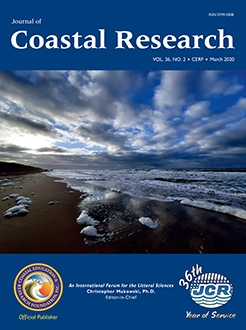Dai, W.; Bilal, A.; Xie, Q.; Ahmad, I., and Joshi, I., 2020. Numerical modeling for hydrodynamics and near-surface flow patterns of a tidal confluence. Journal of Coastal Research, 36(2), 295–312. Coconut Creek (Florida), ISSN 0749-0208.
Because of the flow influx of tributaries, a confluence forms a unique environment carrying interesting hydrodynamic features and other attributes. The understanding of flow behavior here is important, particularly if it is on a tidally influenced channel in a harbor metropolitan. Because of communal requirements, there is a possibility of building wading structures, which may interplay with the flow in this zone. The knowledge of unidirectional river or flume confluences so far is not readily applicable for similar features in channels near coastal areas that have tidal flow in addition to river runoff. In this study, a tidal confluence that has a highly dynamic bidirectional flow is investigated. Near-surface flow patterns in a tidal cycle are simulated by using a numerical model. A field survey provides the bathymetry, time-series boundary conditions, and corresponding verification data. Good agreement is reached between calculated and measured results. Based on the condition of tidal current, four scenarios are selected for which confluence flow patterns are observed, both spatially and temporally. The results indicate that at least one recirculation is always in the tidal confluence for all flow conditions, which rotates counterclockwise for the ebb flow and clockwise for the flood flow. In addition, there is no absolute slack water condition at the tidal junction in the study area. The study also finds that the flows of all three connected channels at the confluence change in a looped pattern with respect to one another. Furthermore, the study reports unique relationships among the ratios of different flows.





